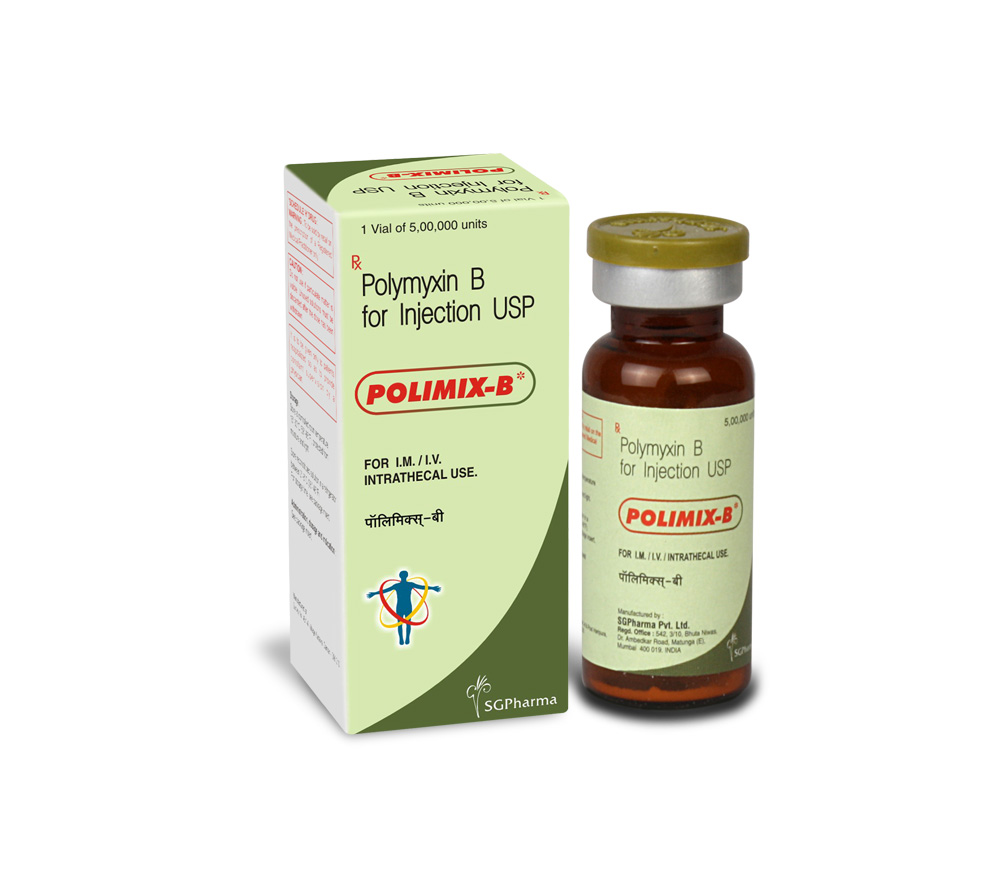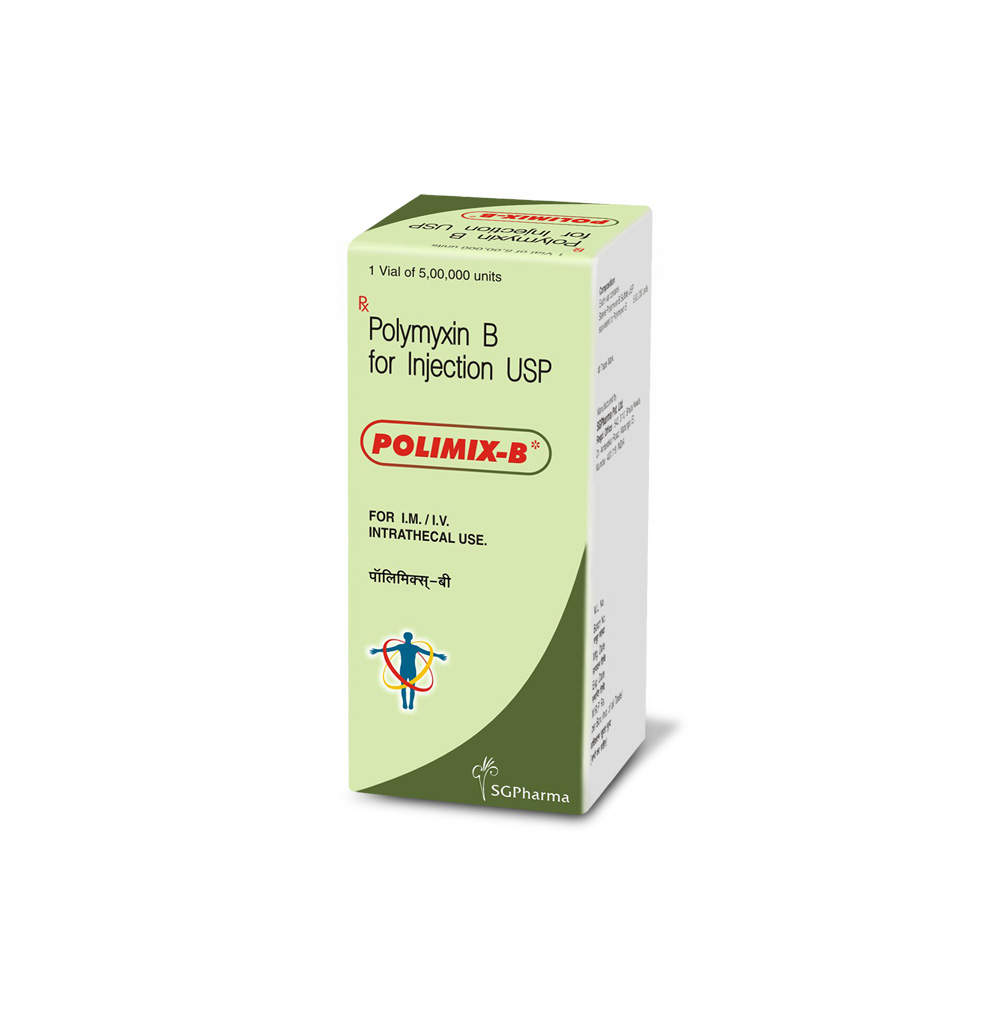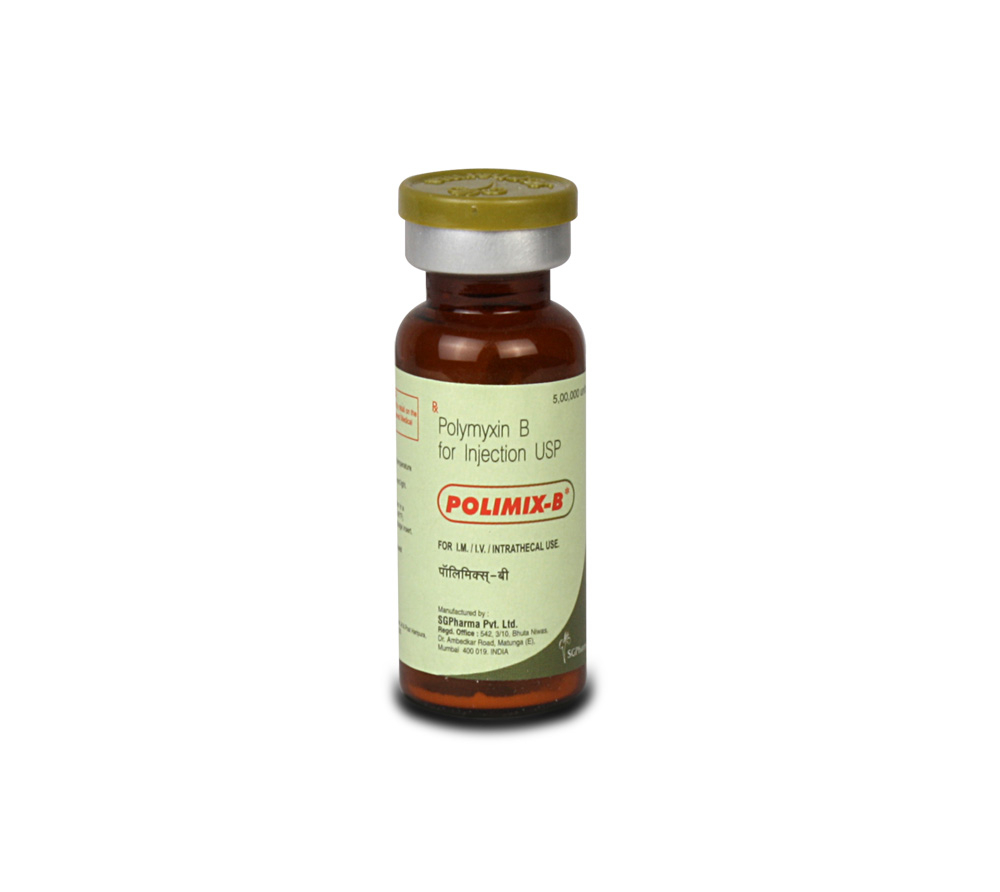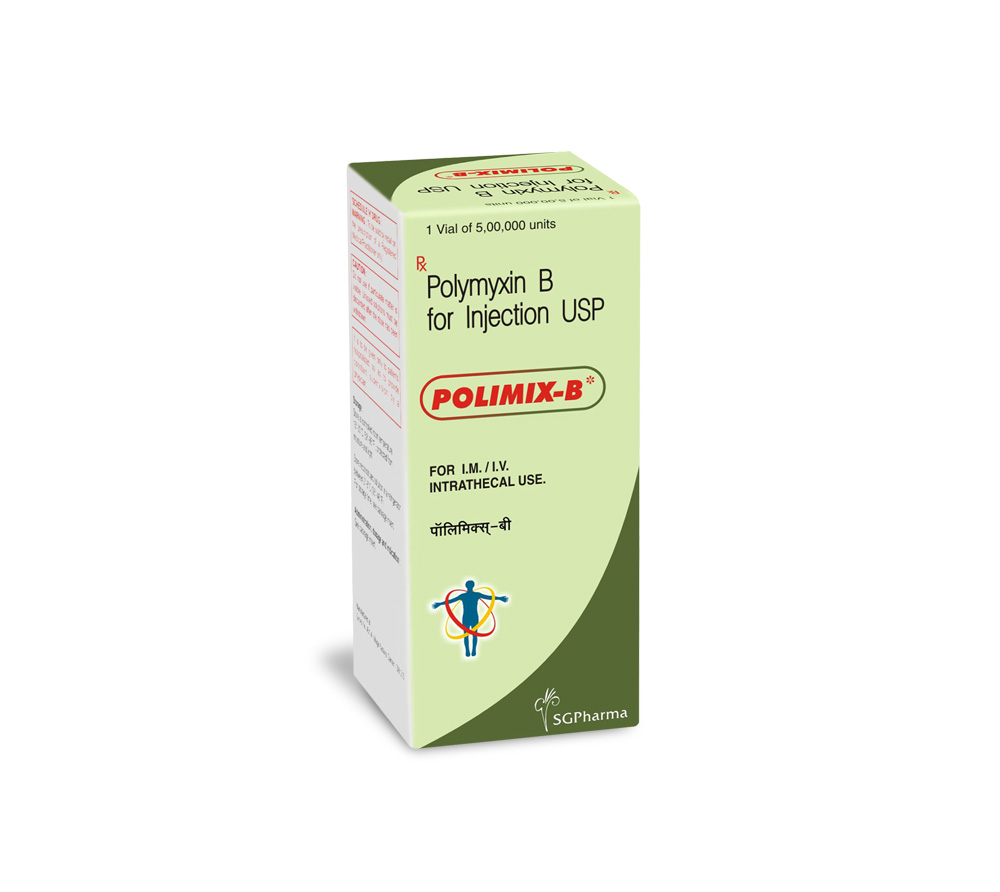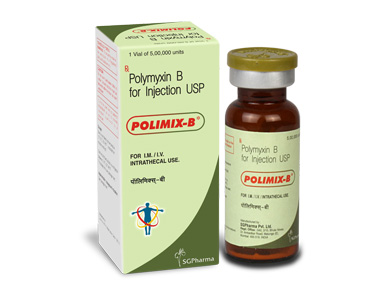
5,00,000 units
For the use of a Registered Medical Practitioner or a Hospital or a Institution only.
POLIMIX-B (Polymyxin B) is one of a group of basic polypeptide antibiotics derived from B polymyxa (B aerosporous). Polymyxin B sulfate is the sulfate salt of Polymyxins B1 and B2, which are produced by the growth of Bacillus polymyxa (Prazmowski) Migula (Fam. Bacillacea). It has a potency of not less than 6000 polymyxin B units per mg, calculated on the anhydrous basis.
STRUCTURAL FORMULA :
Its structural formula is :
-Structure.jpg)
POLIMIX-B is white to buff-colored lyophilized cake in vial of suitable size.
COMPOSITION :
Each vial contains :
Polymyxin B Sulfate USP
equivalent to Polymyxin B 5,00,000 units (Lyophilized)
ACTIONS :
Polymyxin B sulfate has a bactericidal action against almost all gram-negative bacilli except the Proteus group. Polymyxins increase the permeability of bacterial cell wall membranes. All gram positive bacteria, fungi, and the gram-negative cocci, Neisseria gonorrhoeae and Neisseria meningitidis, are resistant. Susceptibility plate testing : If the Kirby-Bauer method of disc susceptibility testing is used, a 300-unit polymyxin B disc should give a zone of over 11 mm when tested against a polymyxin B susceptible bacterial strain. Polymyxin B sulfate is not absorbed from the normal alimentary tract. Since the drug loses 50 percent of its activity in the presence of serum, active blood levels are low. Repeated injections may give a cumulative effect. Levels tend to be higher in infants and children. The drug is excreted slowly by the kidneys. Tissue diffusion is poor and the drug does not pass the blood brain barrier into the cerebrospinal fluid. In therapeutic dosage, polymyxin B sulfate causes some nephrotoxicity with tubule damage to a slight degree.
PHARMACOKINETICS :
Polymyxin B sulfate is not absorbed from the gastrointestinal tract, except in the newborn. It is not absorbed through the intact skin. Peak plasma concentrations after intramuscular use are usually obtained within 2 hours, but are variable and polymyxin B sulfate is partially inactivated by serum. It is widely distributed and extensively bound to cell membranes in the tissues. Accumulation may occur after repeated doses. Polymyxin B is reported to have a half-life of about 6 hours. There is no diffusion into the CSF. Polymyxin B sulfate is excreted mainly by the kidneys, up to 60 % being recovered in the urine, but there is a time lag of 12 to 24 hours before polymyxin B is recovered in the urine.
INDICATIONS :
Acute infections caused by susceptible strains of Pseudomonas aeruginosa. Polymyxin B sulfate is a drug of choice in the treatment of infections of the urinary tract, meninges, and bloodstream caused by susceptible strains of Pseudomonas aeruginosa. It may also be used topically and subconjunctivally in the treatment of infections of the eye caused by susceptible strains of Pseudomonas aeruginosa. It may be indicated in serious infections caused by susceptible strains of the following organisms, when less potentially toxic drugs are ineffective or contraindicated : Haemophilus influenzae, specifically meningeal infections. Escherichia coli, specifically urinary tract infections. Aerobacter aerogenes, specifically bacteremia. Klebsiella pneumoniae, specifically bacteremia.
NOTE : IN MENINGEAL INFECTIONS, POLYMYXIN B SULFATE SHOULD BE ADMINISTERED ONLY BY THE INTRATHECAL ROUTE. To reduce the development of drug-resistant bacteria and maintain the effectiveness of polymyxin B and other antibacterial drugs,
polymyxin B should be used only to treat or prevent infections that are proven or strongly suspected to be caused by susceptible bacteria. When culture and susceptibility information are available, they should be considered in selecting or modifying antibacterial therapy. In the absence of such data, local epidemiology and susceptibility patterns may contribute to the empiric selection of therapy.
Administration :
For Intramuscular, Intravenous and Intrathecal Use.
Dosage :
Intravenous :
Dissolve 5,00,000 polymyxin B units in 300 to 500 ml solutions for parenteral dextrose injection 5 % for continuous drip. Adults and children : 15,000 to 25,000 units/kg body weight/day in individuals with normal kidney function. This amount should be reduced from 15,000 units/kg downward for individuals with kidney impairment. Infusions may be given every 12 hours; however, the total daily dose must not exceed 25,000 units/kg/day. Infants : Infants with normal kidney function may receive up to 40,000 units/kg/day without adverse effects.
Intramuscular :
Not recommended routinely because of severe pain at injection sites, particularly in infants and children. Dissolve 5,00,000 polymyxin B units in 2 ml sterile water for injection or sodium chloride injection or procaine hydrochloride injection 1 %.
Adults and children :
25,000 to 30,000 units/kg/day. This should be reduced in the presence of renal impairment. The dosage may be divided and given at either 4 or 6 hour intervals.
Infants :
Infants with normal kidney function may receive up to 40,000 units/kg/day without adverse effects.
Note : Doses as high as 45,000 units/kg/day have been used in limited clinical studies in treating prematures and newborn infants for sepsis caused by Pseudomonas aeruginosa.
Intrathecal :
A treatment of choice for Pseudomonas aeruginosa meningitis : Dissolve 5,00,000 polymyxin B units in 10 ml sodium chloride injection USP for 50,000 units per ml dosage unit.
Adults and children over 2 years of age : Dosage is 50,000 units once daily intrathecally for 3 to 4 days, then 50,000 units once every other day for at least 2 weeks after cultures of the cerebrospinal fluid are negative and sugar content has returned to normal.
Children under 2 years of age : 20,000 units once daily, intrathecally for 3 to 4 days or 25,000 units once every other day. Continue with a dose of 25,000 units once every other day for at least 2 weeks after cultures of the cerebrospinal fluid are negative and sugar content has returned to normal.
IN THE INTEREST OF SAFETY, SOLUTIONS OF PARENTERAL USE SHOULD BE STORED UNDER REFRIGERATION, AND ANY UNUSED PORTIONS SHOULD BE DISCARDED AFTER 72 HOURS.
TOPICAL :
Ophthalmic : Dissolve 500,000 polymyxin B units in 20 to 50 ml sterile water for injection or sodium chloride injection USP for a 10,000 to 25,000 units per ml concentration. For the treatment of Pseudomonas aeruginosa infections of the eye, a concentration of 0.1 percent to 0.25 percent (10,000 units to 25,000 units per ml) is administered 1 to 3 drops every hour, increasing the intervals as response indicates. Subconjunctival injection of up to 100,000 units/day may be used for the treatment of Pseudomonas aeruginosa infections of the cornea and conjunctiva.
Note : Avoid total systemic and ophthalmic instillation over 25,000 units/kg/day.
CONTRAINDICATIONS :
This drug is contraindicated in persons with a prior history of hypersensitivity reactions to polymyxins.
WARNINGS :
See WARNING box.
PRECAUTIONS :
Prescribing polymyxin B in the absence of a proven or strongly suspected bacterial infection or a prophylactic indication is unlikely to provide benefit to the patient and increases the risk of the development of drug-resistant bacteria. Baseline renal function should be done prior to therapy, with frequent monitoring of renal function and blood levels of the drug during parenteral therapy. Avoid concurrent use of a curariform muscle relaxant and other neurotoxic drugs (ether, tubocurarine, succinylcholine, gallamine, decamethonium and sodium citrate) which may precipitate respiratory depression. If signs of respiratory paralysis appear, respiration should be assisted as required, and the drug discontinued. As with other antibiotics, use of this drug may result in overgrowth of nonsusceptible organisms, including fungi. If superinfection occurs, appropriate therapy should be instituted.
Pregnancy : Pregnancy Category C
Animal reproduction studies have not been carried with Polymixin B sulfate. It is also not known whether Polymixin B sulfate can cause foetal harm when administered to pregnant women or can affect reproduction capacity. Polymixin B sulfate can be given to pregnant women if clearly needed.
Nursing mothers :
It is not known whether this drug is excreted in human milk because many drugs are excreted when Polymixin B sulfate is administered to nursing mother.
INTERACTIONS AND INCOMPATIBILITIES :
Polymyxins may enhance the action of neuromuscular blockers. Additive nephrotoxicity may occur if polymyxins are given with other potentially nephrotoxic drugs including aminoglycosides and cefalotin.
SIDE EFFECTS :
Nephrotoxic reactions : Albuminuria, cylinduria, azotemia, and rising blood levels without any increase in dosage.
Neurotoxic reactions : Facial flushing, dizziness progressing to ataxia, drowsiness, peripheral paresthesias (circumoral and stocking glove), apnea due to concurrent use of curariform muscle relaxants, other neurotoxic drugs or inadvertent overdosage, and signs of meningeal irritation with intrathecal administration, e.g., fever, headache, stiff neck and increased cell count and protein cerebrospinal fluid.
Other reactions occasionally reported : Drug fever, urticarial rash, pain (severe) at intramuscular injection sites, and thrombophlebitis at intravenous injection sites.
INFORMATION FOR PATIENTS :
Patients should be counseled that antibacterial drugs including polymyxin B should only be used to treat bacterial infections. They do not treat viral infections (e.g., the common cold).When polymyxin B is prescribed to treat a bacterial infection, patients should be told that although it is common to feel better early in the course of therapy, the medication should be taken exactly as directed. Skipping doses or not completing the full course of therapy may (1) decrease the effectiveness of the immediate treatment and (2) increase the likelihood that bacteria will develop resistance and will not be treatable by polymyxin B or other antibacterial drugs in the future.
PHARMACEUTICAL PRECAUTIONS :
Parenteral drug products should be inspected visually for particulate matter and discoloration prior to administration, whenever solution and container permit.
STORAGE :
Store at controlled room temperature 15 - 30°C (59 - 86°F), protected from moisture and light. Store reconstituted solution between 2 - 8°C (36 - 46°F). Aqueous solutions of polymyxin B sulfate may be stored up to 12 months without significant loss of potency if kept under
refrigeration. In the interest of safety, solutions for parenteral use should be stored under refrigeration and any unused portion should be discarded after 72 hours. Polymyxin B sulfate should not be stored in alkaline solutions since they are less stable.
SHELF LIFE :
24 months from the date of manufacture.
PRESENTATION :
POLIMIX-B contains Polymyxin B Sulfate USP equivalent to Polymyxin B 5,00,000 units.
Such 10 Vials are packed in a Box.
Disclaimer : For the use of a Registered Medical Practitioner or a Hospital or a Institution only. Also it is not intended to be used by healthcare professionals or patients for the purpose of prescribing or administering these products. Questions regarding the complete and current content of product labeling / specification / presentation should be directed to SGPharma.

 Cardiovascular
Cardiovascular



